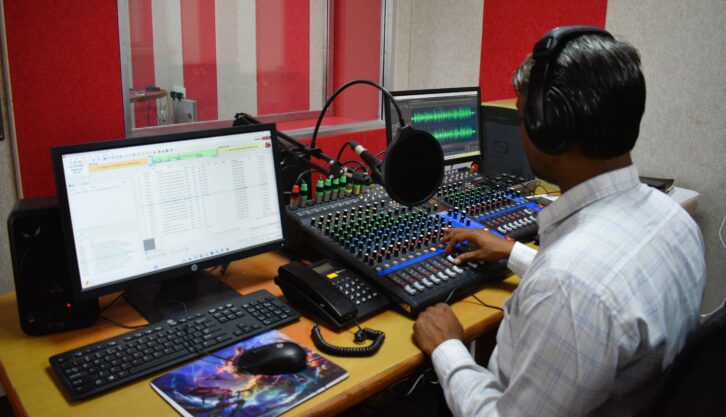Radio World’s “Guest Commentaries” section provides a platform for industry thought leaders and other readers to share their perspective on radio news, technological trends and more. If you’d like to contribute a commentary, or reply to an already published piece, send a submission to [email protected].
The writer is program lead at S M Sehgal Foundation.
Community media may actually do more for development than other social communications. According to the UNESCO studies in the late eighties, led by Frances J. Berrigan, a researcher at the Institute of Educational Technologies, media’s role in society is far more powerful than just supplying information. In a democratic society, media plays a crucial role by providing information to the public and serving as a mirror that describes various social, political and economic activities around us.

In urban areas, numerous channels (TV, radio, social media, podcasts, posters) disseminate information, but rural areas often encounter significant challenges in accessing timely and accurate information.
This discrepancy highlights the need for targeted efforts to bridge the information gap and ensure that all citizens, regardless of location, can stay informed and engaged. Community Radios (CRs) fill this information divide, in the local dialect by the local people, using the relatable content that reach listeners.
The landmark 1995 Supreme Court judgment that declared airwaves as public property to be used to advance public good was instrumental in firmly establishing community radio in India. Since then, CRs have been playing a catalytic role in bringing rural India closer to the national mainstream and serving as a vital tool in strengthening rural development.
Starting in 2002, the Government of India approved a policy for the grant of licenses for setting up of community radio stations to well-established, educational institutions including IITs/IIMs. Considering that community radio represents the voice of the community, the government broadened the policy by bringing nonprofit civil society and voluntary organizations, etc., under its ambit in order to allow greater participation on issues relating to development and social change.
In recent years, the government has taken further proactive steps to enable ease of access in the sector by developing a complete online process for the submission of applications for setting up a community radio station. Community radio stations are operated, owned and influenced by the communities they serve. This serves to play a significant role at the grassroots level for rural development, providing validation and playing a major role in the spread of information. Local voices provide a platform for grassroots communication, promote civic engagement and address local issues through information spread, education and the promotion of community-driven initiatives.
The Power of Localized Content
The importance of community radio in rural development lies in its ability to produce localized content that listeners can easily relate to. For instance, local radio programs are broadcast in regional languages, discussing topics pertinent to the socioeconomic development of the society, such as sustainable farming techniques, health care tips, local governance, government programs and subsidiaries on farming equipment. This information informs and empowers rural residents by providing knowledge that directly impacts their daily lives and livelihoods.
Community radio helps to avail utilities and amenities for various development aspects of our society such as education, health, water and sanitation, protection from natural disasters, addressing social issues at the community level and connecting rural populations with the government. Further, these platforms foster a two-way communication stream. They are not just about disseminating information; they provide a forum for community members to voice their concerns, share experiences and contribute to discussions. This interactive nature of communication encourages greater community involvement and ownership over local development issues that lead to the richer development of society.
The significance of community radio is underscored by programs such as “Mann Ki Baat,” where the Prime Minister of India addresses the nation on various important issues. Having broadcasted more than 110 episodes, this monthly radio show exemplifies the vital role of community radio in engaging with diverse audiences across the country, particularly in rural areas where they are instrumental in development processes.

CRs also have permission to rebroadcast this program for their communities. Recognizing this potential, the Indian government has strengthened their reach. On World Radio Day, February 13, 2024, the Ministry of Information and Broadcasting introduced revised policy guidelines to facilitate the expansion and effectiveness of Community Radio stations (CRs) across India. These updates permit an eligible organization operating in multiple districts to establish up to six CRs in different districts, provided they meet specific criteria. Additionally, the term for the Grant of Permission Agreement has been extended to ten years, reflecting a commitment to ensuring the sustainability and impact of community radios in enhancing grassroots communication and development.
More than 450 community radios are operating currently in India with stations that are the voice of their communities. CR stations such as Connect FM 107.8 (an initiative of S M Sehgal Foundation) amplify the voices of local communities across more than 300 villages, spanning three districts in two states — Alwar and Deeg in Rajasthan and Nuh (Mewat) in Haryana, providing information to farmers with climate-resilient agriculture practices, weather updates, and market information, leading to improved agricultural productivity and income generation. Since most of the listeners are farmers who have not been to school, community radio acts as a substitute for timely agriculture and allied activities information.
CR serves as an informational hub on crucial topics aligned with Sustainable Development Goals (SDGs) such as water management, gender issues, health and hygiene, mental health awareness, financial literacy, education and local cultural nuances. The station plays a pivotal role in community development.
Radio has proven to be an effective medium that emerged as a savior during tough times. In times of crisis, such as natural disasters or pandemics, community media serves as an essential communication tool that disseminates critical information quickly and efficiently, aiding in disaster management and relief efforts. In Rudraprayag, Uttarakhand, community radio “Mandakani Ki Awaaz” extend the primary focus of their regular radio programming to make listeners aware of the handling of natural disasters.
Rural schoolchildren tune in to the radio for education. The Radio School program, created by community radio “Connect,” is a valuable source of information for children in the villages of three districts. The program episodes covered the subjects including math, English and science for primary and secondary classes. Government school teachers also made recordings as part of a campaign facilitated by the State Education Department. Nawed, a Class IX student from village Dhadoli, says he listens to the Radio School program and also makes his younger siblings hear episodes on different subjects.
Overall, community media leverages its grassroots presence to improve lives, contributing effectively to the broader development agenda of the country. Continuing to support and invest in community media creates substantial social transformation in India’s rural landscapes.
Moving forward, radio continues to adapt and survive in new forms, through internet radio stations, live streaming of radios through Radio Garden, podcasts and more. The essence of radio — the voices, music, information and stories — will continue to bring a sense of comfort, connecting generations of listeners like an old friend. Radio celebrates humanity and constitutes a platform for democratic discourse. Globally, radio remains the most widely-consumed medium. Across the planet, radio stations serve distinct communities, offering a wide variety of programs, viewpoints, and content that reflect the diversity of audiences.










